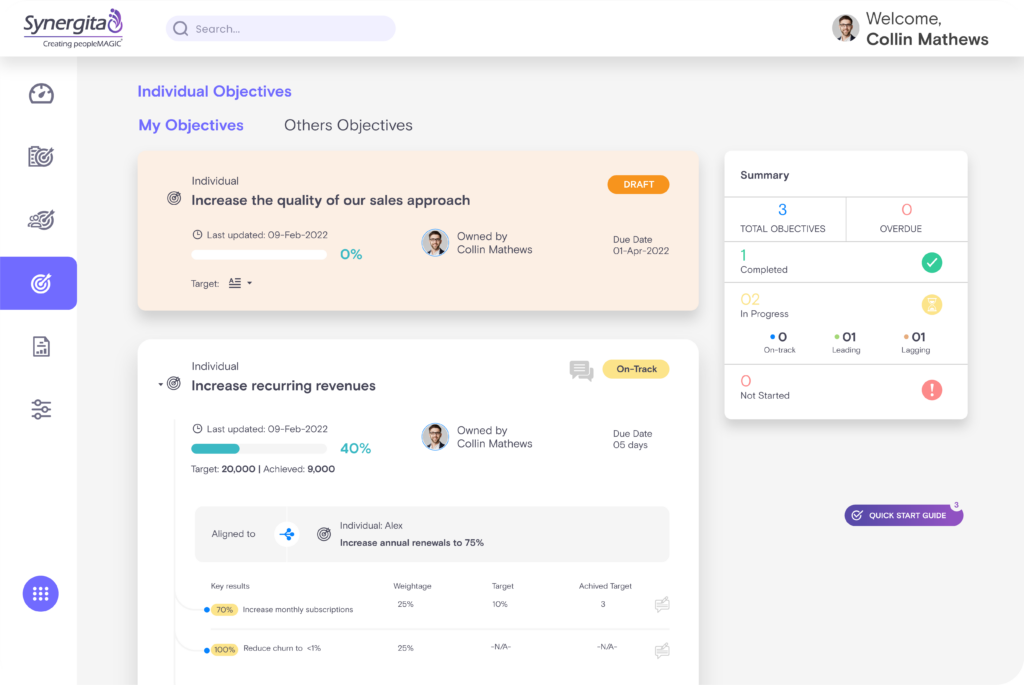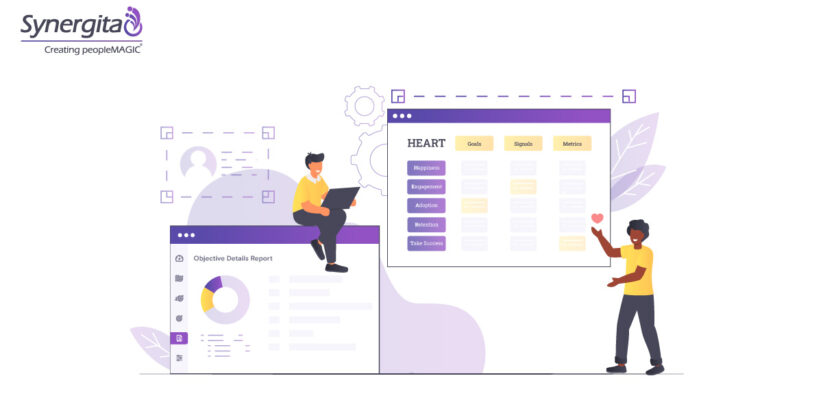OKR or HEART: Which Framework Aligns Best with your Company’s Goals and Culture?
Many corporates are adopting various frameworks available in the market to deliver their best and stay ahead of the competition. In today’s fast-paced world, it is important for individuals and teams to know and clearly understand their company’s objectives and find the best ways to accomplish them. In addition to this, measuring the success of a company’s products or services is crucial to achieving its goals and aligning with its overall strategy. For organizations to stay agile and adaptable, it requires a clear and concise framework for goal-setting and performance management.
Two popular frameworks that have emerged in recent years are OKRs (Objectives and Key Results) and HEART (Happiness, Engagement, Adoption, Retention, and Task Success). The former focuses on setting clear, measurable, and ambitious objectives and tracking progress towards achieving them. The latter is a user-centered framework for measuring the success of the user experience. Choosing the right framework is crucial, as it can help you align your team’s goals, measure progress, and achieve success. One must know the framework inside and out to decide on the one that will work out the best for them.
What is OKR?
OKR is a goal-setting framework used by many successful companies, including Google, LinkedIn, and Intel. The objectives are specific and time-bound goals that align with the company’s overall mission and vision. Key results are quantifiable and measurable milestones that aid the team in tracking the progress towards achieving the goals. OKRs are designed in a way that they are overambitious yet achievable. OKR offers many benefits to the organization, a few of which are listed below:
- Better alignment of goals across teams and departments
- Improved and effective communication
- Increased accountability
- Breaking silos
- Help teams prioritize and focus on the critical task
- Encourages continuous improvement and learning
- Increases employee engagement
What is HEART?
HEART is a framework developed by Google for measuring user experience. As the acronym suggests, HEART measures the following:
- Happiness: measures the user’s satisfaction with the product experience.
- Engagement: measures the degree of user interaction with the product or service.
- Adoption: measures as to how easily one can adapt and start using the product.
- Retention: measures user loyalty and the likelihood of repeat usage.
- Task success: measures the success rate at which the users can efficiently complete their tasks.
This framework helps in evaluating these metrics, which helps in identifying areas for improvement in the user experience of a product or service, a better understanding of user behavior and needs, the ability to track and improve the user experience, and a focus on long-term user retention.

Factors to Consider When Selecting a Framework
Before looking into the factors of selecting the right framework, it is vital to know and understand the differences between OKR and HEART. The differences are presented in the table below.
| OKR | HEART | |
| Meaning | Objective and Key Results | Happiness, Engagement, Adoption, Retention, Task Success |
| Focus | Goal setting and achievement | User experience evaluation |
| Purpose | Define, communicate, and measure goals | Evaluate the user experience |
| Scope | Organizational Level | Product service level |
| Approach | Quantitative | Qualitative and Quantitative |
| Metrics | Numeric and measurable | Numeric and Subjective |
| Timeframe | Typically set on a quarterly basis | Continuously evaluated over time |
| Goal setting | Top-down or bottom-up | Bottom-up or top-down |
| Alignment | Ensures alignment towards company objectives | Ensures alignment towards user experience goals |
| Transparency | Provides transparency on progress | Provides transparency on user experience |
| Applicability | Used in many industries and types of projects | Primarily used in tech and digital product design |
| Limitations | Focuses only on measurable results | Does not provide clear guidance on how to improve metrics |
| Users | Google, Intel, LinkedIn, Twitter, Uber | Google, Facebook, Twitter, Airbnb, Medium |
Here are some factors to consider when selecting between OKR and HEART:
- Company culture: The framework you choose should align with the culture and values of your company. For example, if your company values innovation and experimentation, the OKR framework may be a better fit, as it encourages setting ambitious goals and taking risks.
- Goals and objectives: The framework you choose should be able to measure progress towards your specific goals and objectives. If your goals are focused on revenue growth or customer acquisition, the OKR framework may be more suitable. If your goals are focused on improving the user experience of a product or service, the HEART framework may be more suitable.
- Team structure: The framework you choose should be compatible with the structure of your team. For example, if your team is small and cross-functional, the OKR framework may be a better fit, as it encourages collaboration and alignment across different teams and functions.
- Scope: The framework you choose should be able to measure progress across a wide range of business functions, including sales, marketing, and operations. HEART, on the other hand, is focused specifically on evaluating the user experience of a product or service.
- Data availability: Both frameworks rely heavily on data to measure progress towards objectives. Therefore, the framework you choose should be compatible with the data that is available. For example, if your company lacks the data necessary to track user engagement and satisfaction, the HEART framework may not be the best fit.
- Implementation complexity: The framework you choose should be easy to implement and use. Both the OKR and HEART frameworks require a significant amount of time and effort to implement, but the level of complexity may vary depending on the company’s size and structure.
- Measurability: Both frameworks rely on measurable metrics, but OKR tends to focus more on quantitative metrics such as revenue, sales, or website traffic, while HEART focuses more on qualitative metrics such as user satisfaction, engagement, and task completion rates. Consider what kind of data you have available to measure your project’s success and choose the framework that will allow you to capture that data most effectively.
- Timeframe: OKR tends to be used for short-term goals (e.g., quarterly or yearly), while HEART can be used for both short-term and long-term goals. Consider the timeframe of your project or initiative and choose the framework that aligns best with that timeframe.
- Complexity: OKR tends to be simple and hassle-free to implement, while HEART requires more in-depth analysis and interpretation of user data. Select a framework that can gauge the effectiveness of your project or initiative accurately without making it overly complicated.
OKRs and HEART are powerful frameworks that can help organizations of all sizes set and achieve their goals. By using these frameworks, companies can focus their efforts on what matters most, track progress towards their goals, and continually improve their products and services. Several companies have successfully implemented either the OKR or HEART framework. One notable example of a company that has successfully implemented the OKR framework is Google. Google has been using the OKR framework since its early days, and it has been instrumental in the company’s success. Similarly, a company that has successfully implemented the HEART framework is Airbnb. Airbnb has been using the HEART framework to evaluate the user experience of its platform and make improvements to enhance user satisfaction and engagement. By using the HEART framework, Airbnb has been able to identify areas for improvement and make changes that have led to increased user engagement and satisfaction. When selecting a framework to measure the success of your products or services, it is essential to consider the factors discussed above. Both the OKR and HEART frameworks have their strengths and weaknesses, and the framework you choose should align with your company’s goals and culture. If your company values innovation, experimentation, and ambitious goal setting, the OKR framework may be a better fit. On the other hand, if your company’s goals are focused on improving the user experience of a product or service, the HEART framework may be a better fit. It is also important to consider the structure of your team and the data available to measure progress towards your objectives. The framework you choose should be easy to implement and use and provide a clear sense of direction for your employees. Just like a ship needs a compass to navigate through turbulent waters, it is important for the teams and individuals of a company to have the right framework for their journey towards achieving the company goals. Choosing the right framework to measure the success of your products or services is crucial to achieving your company’s goals and aligning with its overall strategy. Both the OKR and HEART frameworks have their strengths and weaknesses, and the framework you choose should align with your company’s goals, culture, and structure. When selecting a framework, it is important to consider the factors discussed above, including your company’s goals and objectives, team structure, data availability, and implementation complexity. By selecting the right framework, you can provide a clear sense of direction for your employees, measure progress towards your goals, and achieve success in today’s competitive business environment. So, choose wisely and set your team on a course towards success! Examples of Companies that Use OKR and HEART Framework

Choosing the Right Framework for your Organization
Final Note
Related Articles 12 Reasons Why OKRs Work
It is a proven practice adopted by the world’s leading organizations, and its popularity is gaining ground as businesses of all sizes across different industries find OKRs the most effective in setting and meeting Read More.The Ultimate OKR Rollout Checklist For 2023
From planning to implementation, you’ll find all the trivial information on OKR that helps you successfully manage the Read More.
How Adopting OKRs Helps Create Organization Wide Alignment
As a business owner, you have a vision and have devised a mission to accomplish your objectives. You have hired the top performers from the Read More.
How To Create A Complete OKR Checklist
As you know, market competition is at an all-time high. With the transformation of the business environment and the rise of Read More.
